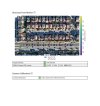I have the Free trial of meta shape, mabey why it is not loading into the system, But what I am is confused. I had all this down really well.
And now I feel I don't know what is going on, was there some change in the systems in the states?
Not sure, but I need to figure this out.
Also, my DD account is almost up and I am so torn on what to get, keep DD, or move on to meta shape or Sim Active, or something else.
I need to produce non-radio metic maps as well, so Sim Active is kinda out. Meta shape is getting more confusing. and DD works great with RTK until you add GCPs or Check into the mix. Just venting my thought here... Thanks
Follow the link in the previous post above to add Geoid 18. Once you fix your State Plane and NAVD88 you should be good on that end.
My biggest problem with Drone Deploy is in my pure opinion it does not support RTK data in a transparent way like Agisoft and Pix4D. They do not tell you if they weight the images RTK derived coordinates and elevations according to the confidnece level assigned to them.
Next with Drone Deploy is that if you just use RTK images collected in ellipsoid heights, your data comes out with ellipsoid heights, not orthometric. My fix was to have to add the steps in the above post with using the Geoid 18 tool and then changing the metadata on all images and this added step takes time.
The datasets I got from you in the past if I remember all had control points using NAD83(2011) ellipsoid. This dataset had the control points using projected State Plane and orthometric heights in feet.
Drone Deploy by far is the best solution for sharing data and making reports. But I think in their effort to make it easy for those who don't understand GCS's and datums they in the end make us users with RTK drones have to work harder.
I did test their elevation calibration tool and it does work pretty well. I made my map with ellipsoid elevations and then calibrated the elevation to a control point with orthometric height. Comparing it to the same output in Agisoft, it was within a cm in 15 different sample areas.
Pix4D mapper has a similar problem. They do not allow local geoid undulation grids and instead you use arbitrary for elevations. It works well for small areas, but some of the more advanced Pix users do complain in their forums that over large areas this starts to become a problem.
You have to comeup with a dedicated workflow and stick to it. I know there are times you might have to change, especially if a project PLS provides control points in something other than your workflow and then you will have to adapt.
Nothing changed in Metashape, you just changed your control points to a projected coordinate system with orthometric heights. This is fine and will work once you make a custom Nevada State Plane East with NAVD88 in US feet and assign Geoid 18 as your undulation grid.
For now I am looking for the easiest metadata editing tool. If you can find an easy one, in the future just collect you control points in GCS NAD83(2011) and ellipsoid. Use Geoid 18 tool to get the geoid undulation. Do the math to get the orthometric height. Use a metadata editor to change the images height to orthometric. Import to Drone Deploy.
Can you answer this one question since you use Drone Deploy far more than me. I know DD wants at least 3 GCPs right? How is it with no GCPs and just 1 or more Check points?









